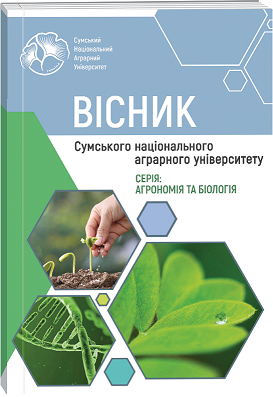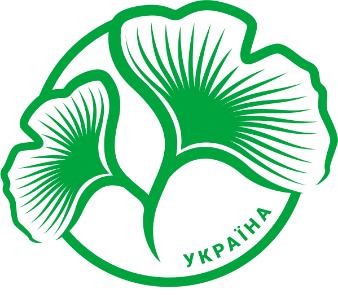КЛІТИННІ МЕХАНІЗМИ РЕЗИСТЕНТНОСТІ СОНЯШНИКУ ДО ПАРАЗИТУ ОROBANCHE CUMANA WALLR.
Анотація
Проведено вивчення процесу зараження Оrobanche сumana різних гібридів соняшнику з неоднаковою стійкістю до паразиту для оцінки клітинних механізмів резистентності. Отримані результати свідчать про те, що усі гібриди соняшнику уражувалися патогеном. Проте ступінь зараження вовчком соняшнику була різною і залежала від неоднакової резистентності гібридів. Гібридів соняшнику, що мали повний імунітет до Orobanche cumana, не було виявлено. При зараженні вовчком реакція резистентності гібридів соняшнику не відбувалася на ранніх стадіях життєвого циклу паразита: перед прикріпленням, після проростання та прикріплення до коренів (до утворення гаусторія) і після формування гаусторія. В обговоренні проаналізовані клітинні механізми виникнення резистентності соняшнику до паразиту. Охарактеризовані молекулярно-генетичні аспекти вродженого імунітету рослин. Узагальнені молекулярні основи резистентності рослин до патогенів. Окреслені нові ефективні підходи контролю на соняшнику паразита Orobanche cumana. З’ясування певних молекулярно-генетичних механізмів стійкості різних гібридів до патогена відкриває новий перспективний напрямок у зменшенні інфікування гібридів паразитом через індукцію системної набутої резистентності (SAR) препаратами, що викликають утворення активних форм кисню і запускають захисні реакції рослин через програмовану смерть клітин у місцях зараження та обумовлюють некроз патогена. У цьому контексті наведені напрямки пошуку нових перспективних хімічних речовин, які можна буде використовувати для розроблення біологічних гербіцидів та фунгіцидів, що є індукторами системної стійкості, для контроля патогена. Розглянуті перспективні сполуки, які індукують роботу сигнальних систем АФК і запускають праймінг захисних реакцій та викликають системну стійкість проти патогенів для лікування вірусних, бактеріальних і фітоплазмових хвороб і контроля паразитичних рослин, які важко контролювати традиційними хімічними методами.
Посилання
2. Al-Khayri, J.M., Rashmi, R., Toppo, V., Chole, P.B., Banadka, A., Sudheer, W.N., Nagella, P., Shehata, W.F., Al-Mssallem, M.Q., Alessa, F.M., Almaghasla, M.I., & Rezk, A.A. (2023). Plant Secondary Metabolites: The Weapons for Biotic Stress Management. Metabolites, 13(6), 716. doi: 10.3390/metabo13060716.
3. Andersen, E.J., Ali, S., Byamukama, E., Yen, Y., & Nepal, M.P. (2018). Disease Resistance Mechanisms in Plants. Genes (Basel), 9(7), 339. doi: 10.3390/genes9070339.
4. Bandaranayake, P.C., Tomilov, A., Tomilova, N.B., Ngo, Q.A., Wickett, N., dePamphilis, C.W., & Yoder, J.I. (2012). The TvPirin gene is necessary for haustorium development in the parasitic plant Triphysaria versicolor. Plant Physiol, 158(2), 1046-53. doi: 10.1104/pp.111.186858.
5. Besserer, A., Puech-Pagès, V., Kiefer, P., Gomez-Roldan, V., Jauneau, A., Roy, S., Portais, J.C., Roux, C., Bécard, G., & Séjalon-Delmas, N. (2006). Strigolactones stimulate arbuscular mycorrhizal fungi by activating mitochondria. PLoS Biol, 4(7), e226. doi: 10.1371/journal.pbio.0040226.
6. Calderan-Rodrigues, M.J., Guimarães Fonseca, J., de Moraes, F.E., Vaz Setem, L., Carmanhanis Begossi, A., & Labate, C.A. (2019). Plant Cell Wall Proteomics: A Focus on Monocot Species, Brachypodium distachyon, Saccharum spp. And Oryza sativa. Int. J. Mol. Sci, 20, 1975. doi:10.3390/ijms20081975.
7. Cartry, D., Steinberg, C. & Gibot-Leclerc, S. (2021). Main drivers of broomrape regulation. A review. Agron. Sustain. Dev, 41, 17. doi:10.1007/s13593-021-00669-0 .
8. Conn, C.E. & Nelson D.C. (2016). Evidence that KARRIKIN-INSENSITIVE2 (KAI2) Receptors may Perceive an Unknown Signal that is not Karrikin or Strigolactone. Front. Plant Sci, 6, 1219. doi:10.3389/fpls.2015.01219.
9. Cvejić, S., Radanović, A., Dedić, B., Jocković, M., Jocić, S., & Miladinović, D. (2020). Genetic and Genomic Tools in Sunflower Breeding for Broomrape Resistance. Genes (Basel), 11(2), 152. doi: 10.3390/genes11020152.
10. Dana, S., Tadmor, Y., Plakhine, D., Ziadna, H., Hübner, S., & Eizenberg, H. (2021). «Biological and Transcriptomic Characterization of Pre-Haustorial Resistance to Sunflower Broomrape (Orobanche cumana W.) in Sunflowers (Helianthus annuus)» Plants 10, 9, 1810. doi:10.3390/plants10091810.
11. Daniel, M. J. & Losner-Goshen, D. (1994). The attachment organ of the parasitic angiosperms Orobanche cumana and O. aegyptiaca and its development. Canadian Journal of Botany, 72(5), 564–574. doi:10.1139/b94-075
12. Doehlemann, G., & Hemetsberger, C. (2013). Apoplastic immunity and its suppression by filamentous plant pathogens. New Phytol, 198(4), 1001-1016. doi:10.1111/nph.12277.
13. Duriez, P., Vautrin, S., Auriac, M.C., Bazerque, J., Boniface, M.C., Callot, C., Carrère, S., Cauet, S., Chabaud, M., Gentou, F., Lopez-Sendon, M., Paris, C., Pegot-Espagnet, P., Rousseaux, J.C., Pérez-Vich, B., Velasco, L., Bergès, H., Piquemal, J., & Muños, S. (2019). A receptor-like kinase enhances sunflower resistance to Orobanche cumana. Nat Plants, 5(12), 1211–1215. doi: 10.1038/s41477-019-0556-z.
14. Echevarría-Zomeño, S., Pérez-de-Luque, A., Jorrín, J., & Maldonado, A. M. (2006). Prehaustorial resistance to broomrape (Orobanche cumana) in sunflower (Helianthus annuus): cytochemical studies, Journal of Experimental Botany, 57, 4189–4200. doi:10.1093/jxb/erl195.
15. Fernández-Aparicio, M., del Moral, L., Muños, S. et al. (2022). Genetic and physiological characterization of sunflower resistance provided by the wild-derived OrDeb2 gene against highly virulent races of Orobanche cumana Wallr. Theor Appl Genet, 135, 501–525. doi:10.1007/s00122-021-03979-9 .
16. Fernández-Aparicio, M., Reboud, X. & Gibot-Leclerc, S. (2016). Broomrape Weeds. Underground Mechanisms of Parasitism and Associated Strategies for their Control: A Review. Front. Plant Sci, 7, 135. doi: 10.3389/fpls.2016.00135.
17. Fernández-Melero, B., del Moral, L., & Todesco, M. (2024). Development and characterization of a new sunflower source of resistance to race G of Orobanche cumana Wallr. derived from Helianthus anomalus. Theor Appl Genet, 137, 56. doi:10.1007/s00122-024-04558-4.
18. Frąckowiak, P., Pospieszny, H., Smiglak, M., Obrępalska-Stęplowska, A. (2019). Assessment of the Efficacy and Mode of Action of Benzo(1,2,3)-Thiadiazole-7-Carbothioic Acid S-Methyl Ester (BTH) and Its Derivatives in Plant Protection Against Viral Disease. Int J Mol Sci, 20(7), 1598. doi: 10.3390/ijms20071598.
19. Furuta, K. M., Xiang, L., Cui, S., & Yoshida, S., (2021). Molecular dissection of haustorium development in Orobanchaceae parasitic plants, Plant Physiology, 186, 1424–1434. doi:10.1093/plphys/kiab153.
20. Hosni, T., Abbes, Z., & Abaza, L. (2020). Effect of broomrape (Orobanche cumana Wallr.) on some agromorphological and biochemical traits of Tunisian and some reference sunflower (Helianthus annuus L.) accessions. J Plant Dis Prot, 127, 831–841. doi:10.1007/s41348-020-00362-6.
21. Kaundun, S.S., Martin-Sanz, A., Rodríguez, M., Serbanoiu, T., Moreno, J., Mcindoe, E. & le Goupil, G. (2024). First case of evolved herbicide resistance in the holoparasite sunflower broomrape, Orobanche cumana Wallr. Front. Plant Sci, 15, 1420009. doi: 10.3389/fpls.2024.1420009 .
22. Khablak, S.G., Abdullaeva, Y.A., & Ryabovol, L.O. (2018). Sensitivity of sunflower hybrids to new races of Broomrape. Factors of Experimental Evolution of Organisms, 23, 55–57.
23. Khan, M., Ali, S., Al Azzawi, TNI, Saqib, S., Ullah, F., Ayaz, A., & Zaman, W. (2023). The Key Roles of ROS and RNS as a Signaling Molecule in Plant-Microbe Interactions. Antioxidants (Basel), 12(2), 268. doi: 10.3390/antiox12020268.
24. Kukin, V. F. (1960). Method of evaluation of sunflower for resistance to infestation. Plant protection from pests and diseases, 7, 39.
25. Labrousse, P., Arnaud, M.C., Griveau, Y., Fer, A., & Thalouarn, P. (2004). Analysis of resistance criteria of sunflower recombined inbred lines against Orobanche cumana Wallr., Crop Protection, 23, 407–413. doi:10.1016/j.cropro.2003.09.013.
26. Le Ru, A., Ibarcq, G., & Boniface, M.C. (2021). Image analysis for the automatic phenotyping of Orobanche cumana tubercles on sunflower roots. Plant Methods, 17, 80. doi:10.1186/s13007-021-00779-6
27. Louarn, J., Boniface, M-C., Pouilly, N., Velasco, L., Pérez-Vich, B., Vincourt, P. & Muños, S. (2016). Sunflower Resistance to Broomrape (Orobanche cumana) Is Controlled by Specific QTLs for Different Parasitism Stages. Front. Plant Sci, 7, 590. doi: 10.3389/fpls.2016.00590.
28. Lozano-Baena, M. D., Prats, E., Moreno, M. T., Rubiales, D., & Pérez-de-Luque, A. (2007). Medicago truncatula as a Model for Nonhost Resistance in Legume-Parasitic Plant Interactions. Plant Physiology, 2, 437–449. doi:10.1104/pp.107.097089.
29. Martín-Sanz, A., Malek, J., Fernández-Martínez, J.M., Pérez-Vich. B., & Velasco, L. (2016). Increased virulence in sunflower broomrape (Orobanche cumana Wallr.) populations from Southern Spain is associated with greater genetic diversity. Front Plant Sci, 7, 589. doi:10.3389/fpls.2016.00589.
30. Maruta, N., Burdett, H., Lim, B.Y.J., Hu, X., Desa, S., Manik, M.K., & Kobe, B. (2022). Structural basis of NLR activation and innate immune signalling in plants. Immunogenetics, 74(1), 5–26. doi: 10.1007/s00251-021-01242-5.
31. Nawu, Y., Matthew, M. A. and Yao, C. (2023). «Roles of Cysteine Proteases in Biology and Pathogenesis of Parasites»Microorganisms 11, 6, 1397. doi.org/10.3390/microorganisms11061397
32. Netea, M.G., Van der Graaf, C., Van der Meer, J.W., & Kullberg, B.J. (2004). Toll-like receptors and the host defense against microbial pathogens: bringing specificity to the innate-immune system. J Leukoc Biol, 75(5), 749-55. doi: 10.1189/jlb.1103543.
33. Pérez-de-luque, A., Rubiales, D., Cubero, J. I., Press, M. C., Scholes, J., Yoneyama, K., Takeuchi, Y., Plakhine, D., & Joel, D. M. (2005). Interaction between Orobanche crenata and its Host Legumes: Unsuccessful Haustorial Penetration and Necrosis of the Developing Parasite, Annals of Botany, 95, 935–942. doi.org/10.1093/aob/mci105.
34. Richmond, B.L., Coelho, C.L., Wilkinson, H., McKenna, J., Ratchinski, P., Schwarze, M., Frost, M., Lagunas, B., & Gifford, M.L. (2022). Elucidating connections between the strigolactone biosynthesis pathway, flavonoid production and root system architecture in Arabidopsis thaliana. Physiol Plant, 174(2), e13681. doi: 10.1111/ppl.13681.
35. Sanabria, N.M., Huang, J.C., & Dubery, I.A. (2010). Self/nonself perception in plants in innate immunity and defense. Self Nonself, 1(1), 40–54. doi: 10.4161/self.1.1.10442.
36. Serghini, K., Pérez de Luque, A., Castejón-Muñoz, M., García-Torres, L., & Jorrín J, V. (2001). Sunflower (Helianthus annuus L.) response to broomrape (Orobanche cernua Loefl.) parasitism: induced synthesis and excretion of 7-hydroxylated simple coumarins, Journal of Experimental Botany, 52, 2227–2234. doi:10.1093/jexbot/52.364.2227.
37. Wan, J., He, M., & Hou, Q. (2021). Cell wall associated immunity in plants. Stress Biology, 1, 3. doi:10.1007/s44154-021-00003-4.
38. Wolf, S., Hématy, K., & Höfte, H. (2012). Growth control and cell wall signaling in plants. Annu Rev Plant Biol, 63, 381-407. doi: 10.1146/annurev-arplant-042811-105449.
39. Yang, C., Liu, R., Pang, J., Ren, B., Zhou, H., Wang, G., Wang, E., & Liu, J. (2021). Poaceae-specific cell wallderived oligosaccharides activate plant immunity via OsCERK1 during Magnaporthe oryzae infection in rice. Nat Commun, 12(1), 2178. doi: 10.1038/s41467-021-22456-x.
40. Yang, C., Xu, L., Zhang, N., Islam, F., Song, W., Hu, L., Liu, D., Xie, X., & Zhou, W. (2017). iTRAQ-based proteomics of sunflower cultivars differing in resistance to parasitic weed Orobanche cumana. Proteomics, 17. doi:10.1002/pmic.201700009.
41. Zhang, Y., Su, J., Yun, X., Wu, W., Wei, S., Huang, Z., & Huang, H. (2022). Molecular mechanism of the parasitic interaction between Orobanche cumana wallr. and sunflowers. Journal of Plant Interactions, 17(1), 549–561. doi:10.1080/17429145.2022.2062061.

 ISSN
ISSN  ISSN
ISSN 



